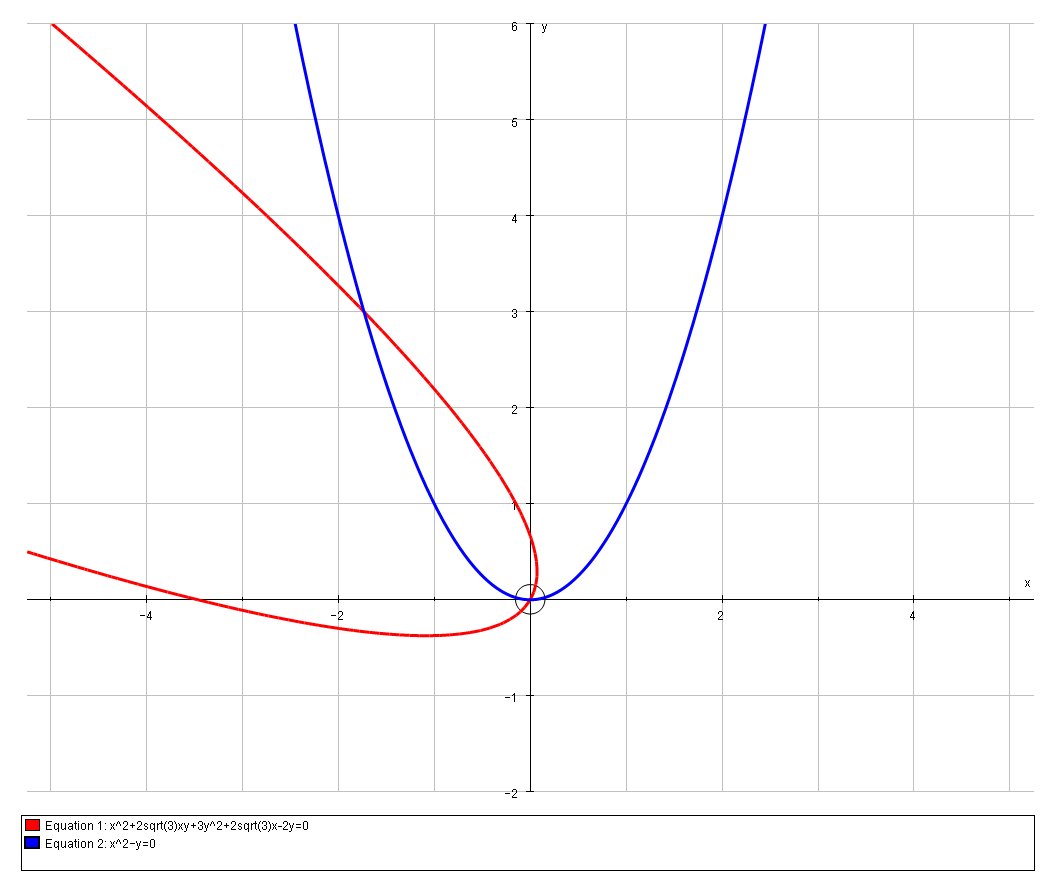What rotation is required to remove the #xy#-term from the conic #x^2+2sqrt(3)xy+3y^2+2sqrt(3)x-2y=0#?
1 Answer
A rotation through
The new translated equation is:
# X^2 - Y=0 #
Which represents a paraobla
Explanation:
We have:
# x^2+2sqrt(3)xy+3y^2+2sqrt(3)x-2y=0 #
Comparing to the conic equation in standard form:
# Ax^2 + Bxy + Cy^2 + Dx +Ey + F = 0 #
We have:
# A=1; \ B=2sqrt(3); \ C=3; \ D=2sqrt(3); \ E=-2; \ F=0 #
The rotation angle,
# cot 2theta = (A-C)/B = (1-3)/(2sqrt(3) = -1/(sqrt(3) #
# :. 2theta = (2pi)/3 => theta = (2pi)/6 #
We will need
# sin theta = (sqrt(3))/2; \ \ \ \ cos theta = 1/2 #
The rotation matrix to transform from
# ( (x),(y) ) = ( (cos theta, -sin theta), (sin theta, cos theta) ) ( (X),(Y) )#
# " " = ( (1/2, -(sqrt(3))/2), ((sqrt(3))/2, 1/2) ) ( (x'),(y') )#
Leading to the transformation equations:
# x = 1/2 X-sqrt(3)/2 Y; \ \ \ \ y = sqrt(3)/2 X + 1/2 Y #
We can substitute these transformation equations into the original equation to get the new equation (which should be deficient in an
# (1/2 X-sqrt(3)/2 Y)^2+2sqrt(3)(1/2 X-sqrt(3)/2 Y)(sqrt(3)/2 X + 1/2 Y)+3(sqrt(3)/2 X + 1/2 Y)^2+2sqrt(3)(1/2 X-sqrt(3)/2 Y)-2(sqrt(3)/2 X + 1/2 Y)=0 #
We can remove the fractions to make the algebra slightly less tedious, by multiplying by
# (X-sqrt(3)Y)^2 + 2sqrt(3)(X-sqrt(3)Y)(sqrt(3)X + Y) + 3(sqrt(3) X + Y)^2 + 4sqrt(3)(X-sqrt(3)Y) - 4(sqrt(3) X + Y) = 0 #
And now we multiply out and collect terms:
# (X^2-2sqrt(3)XY+3Y^2) + 2sqrt(3)(sqrt(3)X^2+XY-3XY-sqrt(3)Y^2) + 3(3X^2+2sqrt(3)XY+Y^2) + 4sqrt(3)(X-sqrt(3)Y) - 4(sqrt(3) X + Y)=0 #
# :. X^2-2sqrt(3)XY+3Y^2 + 6X^2-4sqrt(3)XY-6Y^2 + 9X^2 + 6sqrt(3)XY + 3Y^2 + 4sqrt(3)X - 12Y - 4sqrt(3)X - 4Y=0 #
# :. 16X^2 - 16Y=0 #
# :. X^2 - Y=0 #
Which in the
The graphs of the two equation (on the same image) as as follows:

And we can graphically confirm that the original equation is the same parabola rotated through

